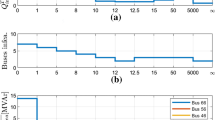Abstract
In this paper we present a new approach to solve the DC (n − 1) security constrained optimal power flow (SCOPF) problem by a structure exploiting interior point solver. Our approach is based on a reformulation of the linearised SCOPF model, in which most matrices that need to be factorized are constant. Hence, most factorizations and a large number of back-solve operations only need to be performed once. However, assembling the Schur complement matrix remains expensive in this scheme. To reduce the effort, we suggest using a preconditioned iterative method to solve the corresponding linear system. We suggest two main schemes to pick a good and robust preconditioner based on combining different “active” contingency scenarios of the SCOPF model. These new schemes are implemented within the object-oriented parallel solver (OOPS), a structure-exploiting primal-dual interior-point implementation. We give results on several SCOPF test problems. The largest example contains 500 buses. We compare the results from the original interior point method (IPM) implementation in OOPS and our new reformulation.







Similar content being viewed by others
References
Alsac O, Stott B (1974) Optimal load flow with steady-state security. IEEE Trans PAS 93(3):745–751. doi:10.1109/TPAS.1974.293972
Alsac O, Bright J, Prais M, Stott B (1990) Further development in lp-based optimal power flow. IEEE Trans Power Syst 5(3):697–711
Altman A, Gondzio J (1999) Regularized symmetric indefinite systems in interior point methods for linear and quadratic optimization. Optim Methods Softw 11/12(1–4):275–302
Capitanescu F, Glavic M, Ernst D, Wehenkel L (2007) Interior-point based algorithms for the solution of optimal power flow problems. Electr Power Syst Res 77(5–6):508–517. doi:10.1016/j.epsr.2006.05.003
Carpentier J (1962) Contribution à à l’Étude du dispatching Économique. Bulletin de la Société Françise des Électricit 3:431–447
Dommel H, Tinney W (1968) Optimal power flow solutions. IEEE Trans PAS 87:1866–1876
Golub GH, van Loan CF (1983) Matrix computations. North Oxford Academic, Oxford
Gondzio J, Grothey A (2009) Exploiting structure in parallel implementation of interior point methods for optimization. Comput Manag Sci 6(2):135–160
Karoui K, Platbrood L, Crisciu H, Waltz R (2008) New large-scale security constrained optimal power flow program using a new interior point algorithm. In: Electricity market (EEM) 2008. 5th international conference on European, pp 1–6. doi:10.1109/EEM.2008.4579069
Kelley CT (1995) Iterative methods for linear and nonlinear equations. Frontiers in applied mathematics, vol 16. SIAM, Philadelphia
Kirschen DS, Strbac G (2004) Fundamentals of power system economics. Wiley, Hoboken
Petra C, Anitescu M (2010) A preconditioning technique for Schur complement systems arising in stochastic optimization. Technical report of Argonne National Laboratory, Argonne, IL, to appear in computational optimization and applications, preprint ANL/MCS-P1748-0510
Qiu W, Flueck A, Tu F (2005) A new parallel algorithm for security constrained optimal power flow with a nonlinear interior point method. In: Power engineering society general meeting, 2005, IEEE, vol 1, pp 447–453. doi:10.1109/PES.2005.1489574
Quintana V, Torres G, Medina-Palomo J (2000) Interior-point methods and their applications to power systems: a classification of publications and software codes. IEEE Trans Power Syst 15(1):170–176. doi:10.1109/59.852117
Stott B, Jardim J, Alsaç O (2009) DC power flow revisited. IEEE Trans Power Syst 24:1290–1300
Trodden PA, Bukhsh WA, Grothey A, McKinnon KIM (2013) MILP formulation for controlled islanding of power networks. Int J Electr Power Energy Syst 45(1):501–508
Wei H, Sasaki H, Yokoyama R (1996) An application of interior point quadratic programming algorithm to power system optimization problems. IEEE Trans Power Syst 11(1):260–266. doi:10.1109/59.486104
Wright SJ (1997) Primal-dual interior-point methods. Society for Industrial and Applied Mathematics (SIAM), Philadelphia
Zimmerman RD, Murillo-Sanchez CE, Thomas RJ (2011) MATPOWER: steady-state operations, planning and analysis tools for power systems research and education. IEEE Trans Power Syst 26(1):12–19
Acknowledgments
We are grateful to the anonymous referees and the journal editors, whose many useful suggestions have significantly improved the paper.
Author information
Authors and Affiliations
Corresponding author
Rights and permissions
About this article
Cite this article
Chiang, N., Grothey, A. Solving security constrained optimal power flow problems by a structure exploiting interior point method. Optim Eng 16, 49–71 (2015). https://doi.org/10.1007/s11081-014-9250-1
Received:
Accepted:
Published:
Issue Date:
DOI: https://doi.org/10.1007/s11081-014-9250-1




